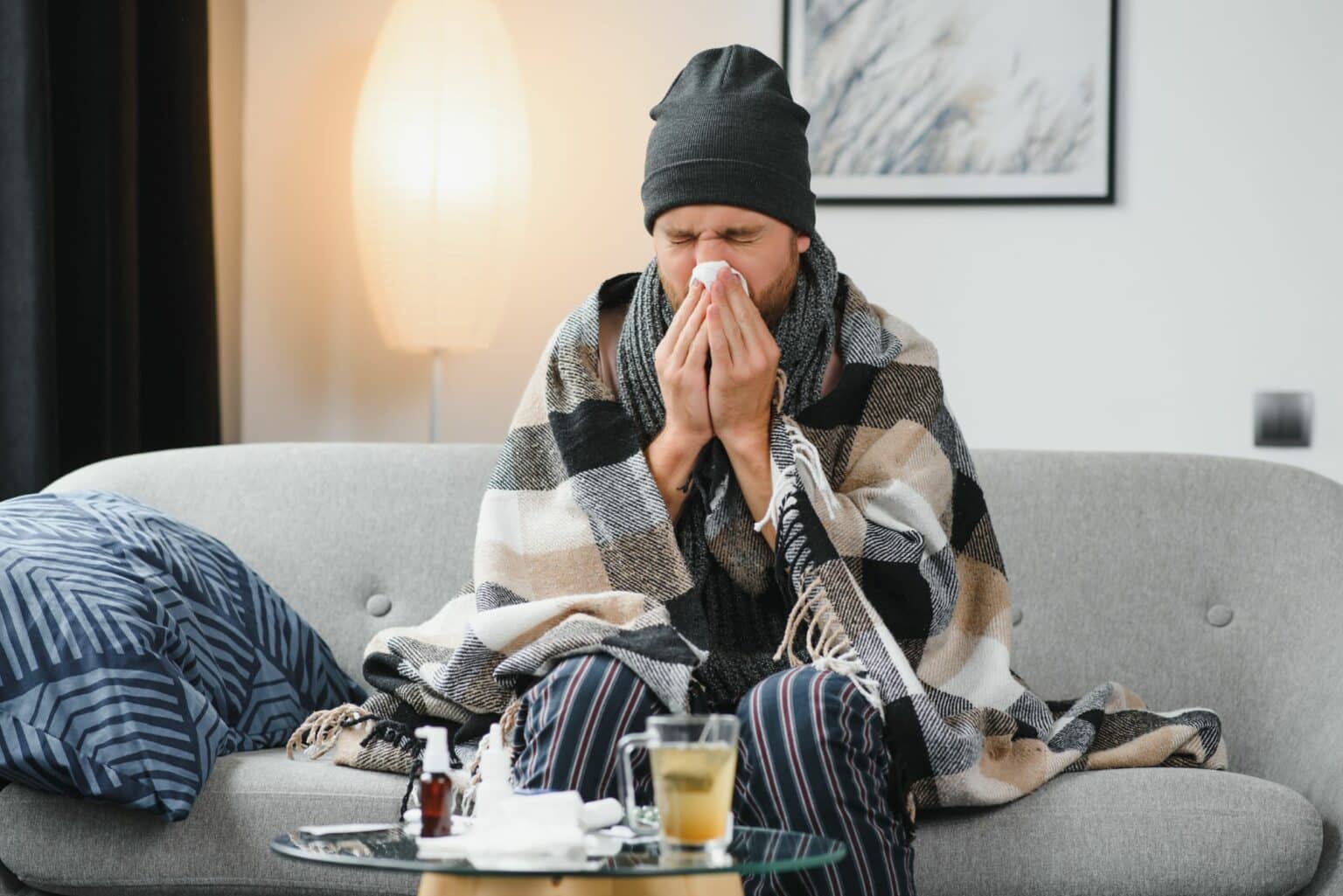


As a general rule of thumb, it is not recommended to continue running when you have a cold. Running with a cold can make the cold worse, as it is an illness caused by a viral infection and can affect your entire respiratory system, making it difficult for you to breathe properly while engaging in physical activity.
Running with a cold can also make you more susceptible to other health issues, such as bronchitis or pneumonia. This is because your immune system is already compromised due to fighting off the virus causing your cold.
Additionally, running with a cold can prolong the duration of your illness. When you engage in physical activity, your body produces stress hormones that can weaken your immune system and hinder its ability to fight off the infection.
In this article, we answer the question: “Should I keep running with a cold?”. We discuss the potential risks of running with a cold and provide alternative forms of exercise that can help you maintain your fitness while allowing your body to recover.
Before we dive into the impact of running on a cold, it is important to understand how the common cold affects our body. A cold is a viral infection that primarily targets the upper respiratory system, including the nose, throat and sinuses. The most common symptoms include a runny or stuffy nose, sore throat, coughing and sneezing.
According to the ‘neck symptoms’ rule, symptoms above the neck, such as those affecting the sinuses and throat, generally allow for continued physical activity, while symptoms below the neck, including chest congestion and body aches, indicate a need for rest.
When our body is exposed to a virus, such as the one causing a cold, our immune system kicks into gear and attempts to fight off the infection. This process can take several days or even up to two weeks for your body to fully recover.
Engaging in physical activity while your immune system is busy fighting off an infection can be counterproductive and potentially harm your overall health.
Running can have both positive and negative effects on the immune system, depending on the intensity and duration of the exercise. Moderate exercise, such as running, can help boost the immune system by increasing the production of white blood cells, which fight off infections. Research has shown that engaging in moderate exercise can reduce the severity and duration of cold symptoms, making it a beneficial activity when done correctly.
Running also helps reduce stress, which is known to weaken the immune system. By lowering stress levels, you can enhance your body’s ability to fend off illnesses. However, it’s important to note that high-intensity or prolonged running can have the opposite effect. Overtraining or running with severe symptoms can suppress the immune system, making you more susceptible to illness and prolonging recovery time.
To avoid compromising your immune system, it’s essential to listen to your body and adjust your running routine accordingly. If you feel that your cold symptoms are worsening or if you experience severe symptoms, it’s best to take a break and allow your body to recover fully.
Should you run with a cold? The decision ultimately depends on the severity of your symptoms. If you have a mild cold and are experiencing symptoms above the neck, such as a runny nose or sore throat, it may be safe to continue running at a slower pace.
However, if you are experiencing more severe symptoms such as chest congestion, fever, or body aches, it is best to take a break from running and allow your body to rest and recover.
It is also essential to listen to your body and not push yourself too hard while running with a cold. If you feel exhausted or overly fatigued, it is best to stop and rest.
Running with a cold can increase your risk of developing more serious health issues, such as bronchitis or pneumonia. As mentioned earlier, physical activity can weaken your immune system and make it harder for your body to fight off the infection, potentially making symptoms worse.
On the other hand, if you have a mild cold and decide to continue running, it may help relieve some of your symptoms by opening up your airways and releasing endorphins that can improve your mood.
However, these benefits are typically short-lived and do not outweigh the potential risks associated with running while sick.

If you decide to continue running with a cold, you should take precautions to minimise its impact on your body. Wear appropriate clothing to shield yourself from the cold and stay hydrated to prevent dehydration. Carry tissues or a handkerchief to manage a runny nose. It’s best to avoid running in cold weather with a cold, as it can worsen symptoms like nasal congestion. If you experience abnormal sweating, dizziness, or feel worse during or after your run, stop and rest.
Listen to your body and adjust your pace as needed. It’s crucial not to push yourself too hard or try to stick to your regular running routine.
If you decide to run with a cold, there are several tips to keep in mind to minimise the risk of complications and reduce the severity of symptoms. First, start with a gentle warm-up and cool-down to prevent shocking your system. This helps prepare your body for the physical activity and aids in recovery afterwards.
Reduce the intensity and duration of your run to avoid putting excessive strain on your body. Running with a cold should be about maintaining fitness, not pushing your limits. Stay hydrated by drinking plenty of fluids before, during, and after your run. Hydration is crucial, especially when dealing with cold symptoms like nasal congestion and a runny nose.
Avoid running in extreme weather conditions, such as high winds or freezing temperatures, as these can exacerbate your symptoms. Consider running indoors or on a treadmill to reduce exposure to allergens and irritants that could worsen your condition. Using a nasal decongestant or saline nasal spray can help alleviate nasal congestion, making it easier to breathe while running.
Most importantly, avoid running with a fever, as this can increase the risk of dehydration and heat-related illness. If you experience any severe symptoms, such as chest pain or difficulty breathing, stop running immediately and seek medical attention. Remember, it’s always better to err on the side of caution when running with a cold. If you’re unsure about whether to run or not, consult with a medical professional for personalised advice.

If you do choose to take a break from running while you recover from a cold, there are still plenty of alternative forms of exercise that can help you maintain your fitness level.
Some low-impact options include yoga, pilates, or walking. If you have a minor sore throat, low-impact exercises like yoga or walking can still be beneficial. These activities can help improve flexibility and stamina without putting too much strain on your body.
You could also try some light strength training exercises, such as bodyweight exercises or using light weights. This will not only keep your muscles active but also provide a good cardiovascular workout.
Once your cold symptoms have subsided and you feel better, it’s crucial to gradually ease back into your running routine. Begin with shorter distances and slower paces, allowing your body time to readjust and fully recover. Wait at least 24 hours after your symptoms have disappeared before resuming training, especially if you’ve experienced a fever. If you have had severe symptoms like a hacking cough, you should wait until these symptoms have fully subsided before resuming running. Start with short, easy-paced runs and slowly rebuild your distance. Incorporate walk breaks into your runs to help improve your fitness and extend your distance.
Listen to your body and resist the urge to rush back into training too quickly. It may take a few sessions to regain your pre-cold fitness level, but it’s important not to push yourself too hard at the start.
It’s essential to remember that if you are experiencing symptoms similar to a heavy cold, it could also be due to Covid-19. In this case, it is best not to engage in physical activity and seek medical advice as soon as possible. Respiratory infections, including Covid-19, require special attention and medical advice before resuming physical activity.
In our Ask the Coach article, Missed a Week of Training Due to Illness, our Head Coach, Mike Gratton, delves into the topic of running after recovering from COVID-19.
He advises that: ‘Covid seems to affect runners in different ways. Most of my runners have had COVID-19, some showed little in the way of symptoms but could tell something wasn’t right and training had become more difficult. Others have been knocked for six and reduced to exhaustion. In the first case, I have found runners with no or unnoticeable symptoms have been able to return to full running after 5 to 7 days off. However, others have taken a month or so to start feeling normal again. It’s a difficult one for a coach, and the only way is to take things day-by-day, forget the training programme and get a feel for when things start to get better and build back carefully. This may require you to abandon your racing plans.’
‘I was always advised to take my pulse rate every morning and establish a baseline – for me, around 40 beats/min when I was a fit younger man – then, if in the morning you find your pulse is higher by 5 or so beats/min it is an indication either of overtraining or an illness about start. In this case, you have early warning and can plan to reduce and have an easy week.’
Preventing illness is always preferable, and maintaining a diet rich in vitamins, iron, and zinc can greatly contribute to this goal. To support your health, consider taking a multivitamin supplement like Holland & Barrett’s Multivitamins and a zinc supplement. A ginger and turmeric shot, like the Good Energy – Mighty Ginger and Chilli Shot, can also help boost your immune system and fight off infections.
There are further things you can do to decrease the risks of getting ill. For example:
By taking these precautions, you can reduce your chances of catching a cold or other illness and continue running at full capacity. Remember to listen to your body, take breaks when necessary, and gradually ease back into training after recovering from an illness.
Running with a cold can be challenging, but it is possible to do so safely while allowing yourself time to heal. Consider alternative forms of exercise, adjust your pace and listen to your body while running with a cold. If you suspect that you may have Covid-19, seek medical advice and avoid physical activity until you have fully recovered.
Remember to take preventative measures like maintaining a healthy diet supplemented by multivitamins and zinc. Additionally, wash your hands frequently to reduce the risk of falling ill in the first place.
By taking care of yourself and being aware of your body’s signals, you can continue running while managing a cold effectively. Stay safe and listen to your body’s needs, and you will be back on track in no time.
Join our mailing list to stay up to date with the latest UK running events, training tips, and exclusive offers on running products. Rest assured, we value your privacy and would never dream of selling your address. Sign up now…
Share this article
I completed the London Marathon, an incredible experience I’ll never forget. However, I can’t help...
Welcome to our Coach the Run’s elite marathon training plan. If you are looking to...
Running coaches are professionals who specialise in training and guiding individuals in improving their running...
I have a spring marathon, I’m a beginner and never done a marathon. I see...
AI coaching is transforming the way runners train, offering personalised plans and real-time feedback through...
The Boston Marathon is the world’s oldest annual marathon, hosted by several cities in Massachusetts,...
We’re here to make sure you’re up-to-date with the latest running tips, events and product discounts – we’ve always got your back! Rest assured, we value your privacy and would never dream of selling your address.
BONUS: Sign up today and receive a FREE code for our Sub-4-Hour Marathon Plan